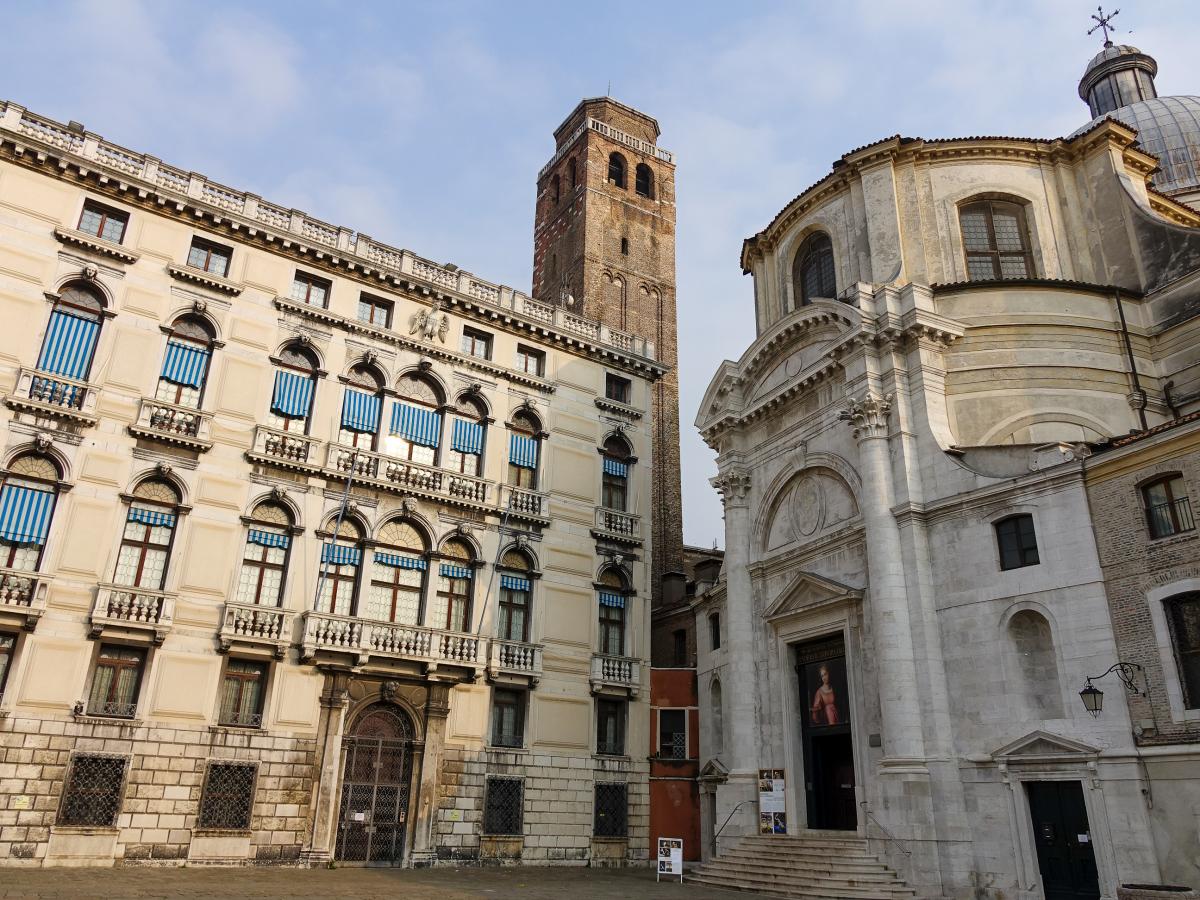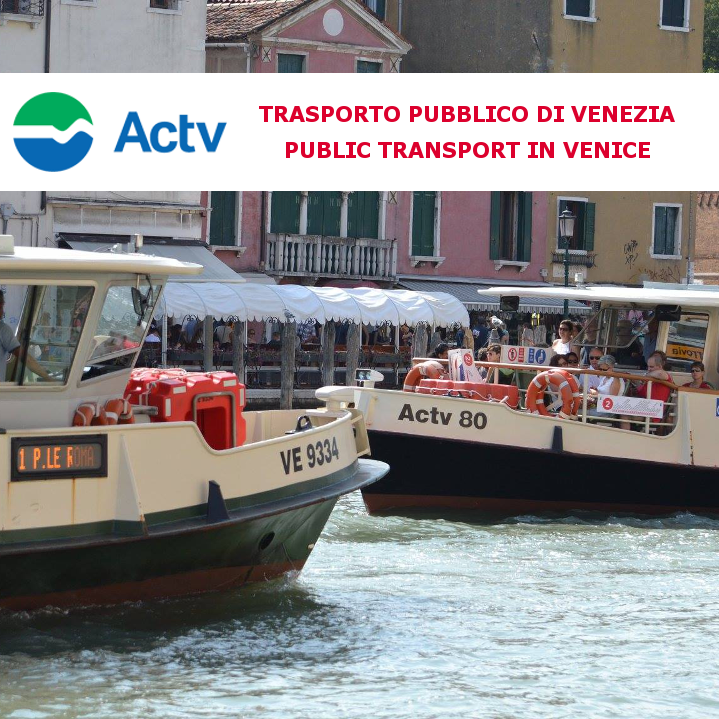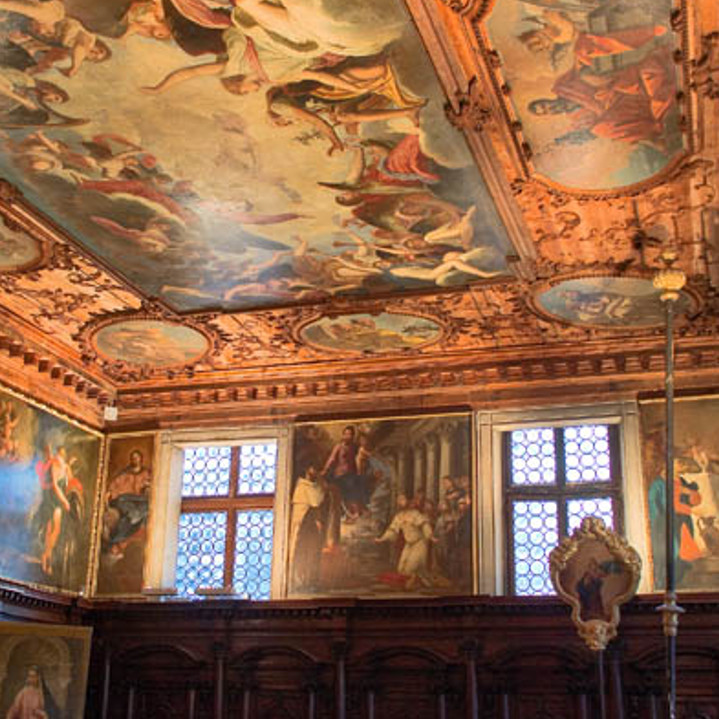You are here
Crossroads of the world: jews, moors and christians
Crossroads of the world: jews, moors and christians
This itinerary takes us from the railways station Santa Lucia through the Cannaregio district, possibly named after the large amount of reeds growing in this area. When no one knows, as history and legend mingle in Venice, making it very difficult to tell one from the other.
Come discover the town’ s art, history and crafts by following these itineraries, and discover three high quality workshops: Emporio etico Filò houses a leather goods workshop, while Plum Plum Creations is specialised in the ancient art of printing and engraving, finally Momylia creates lume glass beads according to tradition.
On our stroll along Calli and Campielli within the district you can find some typical Venetian taverns called "bacari”, which have a pulpy character, where you can eat the "cichetti". These are snacks mostly based on fish, served on bread or polenta with small portions of "sarde in saor", baccalä mantecato (that is creamy cod), eggs, shrimp, various salami and more besides. The “cicchetti” are always strictly accompanied by an "ombra", that is a good glass of wine such as Merlot, Cabernet, Pinot Grigio.
The Site “Venice and its Lagoon” has been inscribed on the World Heritage List since 1987 due to its Outstanding Universal Value, therefore it belongs to all of us: it is our common duty to respect it and preserve it so that it may be passed on to future generations.
The cultural heritage of the Site goes beyond the walls of palaces, churches, beyond islands and the lagoon, but is also memory, identity, community, all fundamental elements for the its vitality.
For this very reason the City Council launched the campaign #Enjoy/RespectVenezia in 2017, to raise awareness among the visitors and to encourage them to behave in a polite and correct manner during their stay, respecting the town and its inhabitants by keeping the right when walking on the streets, not stopping and sitting on the bridges, not feeding the pigeons and by respecting the place they are visiting keeping an appropriate behaviour.
- Duration: about 2.45 hours
- Lenght: about 1.8 Km (just over 1 mile)
- Mode of travel: the tour takes place entirely on foot
- Recommended period: This itinerary is feasible tthe whole year round, however it is best to carry it out in the morning in summer time,and in the late morning or early afternoon in winter time, due to the lack of shelter from adverse weather conditions. It might be necessary to alter slightly the route due to the weather, especially duting a “acqua alta” (high tide)
- Accessibility: This tour is accessible to all those who can move normally, even with a stroller or are visually impaired or blind. It is not completely accessible for those moving on a wheelchair. In that case one can take the public transport ACTV line 5.1/5,2 and 4.1/4.2 Ri to the stop Guglie to reach the Ghetto area and be able to visit at least two of the craftsmen. It is advised to check each time the degree of disability, in order to adjust the tour to the individual needs. For more information pleaee visit the web section "Disability" of the City of Venice web site
- Departure: Railways station “Venezia Santa Lucia”
- Arrival: Strada Nova, by Chiesa di San Felice
-
Points of interest:
1. Chiesa degli Scalzi
2. Campo San Geremia - Chiesa di San Geremia e Lucia - Palazzo Labia
3. Jewish Ghetto
4. Tintoretto's House
5. Campo dei Mori
6. Chiesa della Madonna dell’Orto
7. Scuola Grande della Misericordia - District: Cannaregio
- Interconnection with other itineraries: "Hidden gems of Venice"
Listen to the audio tour

Casa del Tintoretto
ph. Giorgio Bombieri - Comune di Venezia

Ghetto Ebraico
ph. Giorgio Bombieri - Comune di Venezia
Starting point: Venezia Santa Lucia railway station
Let’s start by walking from the railways station Santa Lucia, which owes its name to the church, where her body was preserved, and which had been standing there until 1861; some say it designed by the great architect Palladio. Have a look at the pavement, you will see a plaque commemorating the building.
The holy maiden was moved to the nearby San Geremia and Lucia Church, which we will see soon on our way. Next to the station stands the Chiesa degli Scalzi ("scalzo" means barefoot), named after the Carmelites, who still live there (www.chiesadegliscalzi.it/ch/).
In fact, its real name is Santa Maria di Nazareth, built in the early 1700s, whose ceiling, painted by G.B Tiepolo, represented the Flight of the Holy House of the Virgin Mary to Loreto. This work of art was destroyed by a fire caused by a bomb in 1915. In the Manin Chapel rests Ludovico Manin, the last Venetian Doge.
If you have time take some to visit the Mystical Garden and buy some melissa water (information for booking your visit: visitegiardinomistico@gmail.com, info@giardinomistico.it).

Piazzale della stazione ferroviaria Venezia Santa Lucia
ph. Gabriele Vattolo - Comune di Venezia
Stage 1: From "Venezia Santa Lucia" railway station to the Jewish Ghetto, with a tour of Emporio Etico Filò workshop
Keep going straight along the Lista di Spagna, where Palazzo Seriman stands, nowadays one of the seats of the Regional Administration, once the Spanish Embassy to the Serenissima.
You then reach Campo SS. Geremia e Lucia, where an impressive church stands at our eight hand side. This is in where St. Lucia is worshipped, while on its left hand side we see the elegant Palazzo Labia built in the 1700s, and whose spectacular ballroom was decorated with frescoes by G.B.Tiepolo. Legend has that the Labias used to serve meals in gold crockery, which was then thrown out of the windows into the canal after each course, to impress their guests. Apparently, their servants collected the crockery after each throw. On this campo, which means square in Venice, bull fighting took place at Carnival time. You now take the calle (Venetian for street) leading us to the Ponte delle Guglie, built in 1580 and decorated with pinnacles (guglie) in 1823. In 1987 this bridge was made accessible to disabled people thanks to low steps and rails.
You cross the bridge and turn left onto the Fondamenta di Cannaregio and turn right into the Sotoportego del Gheto, where the holes in the walls remind you of the gate which was shut at sunset, thus isolating the Jews from the city. Going along the street you pass the kosher restaurant, where you can taste dishes of the Jewish tradition, and reach the Campiello dele Scuole. Here you notice the very tall buildings as well as the Levantine synagogue on the right and the Spanish synagogue on the left, built at the end of the 15oos and still open for worship. “Scuola” in Venetian stands for place of gathering.
Few steps away you find our first craftsmen working leather by hand at the Emporio Etico Filò. For enquiries and to book a visit call Cooperativa il Filò: 0039/041/5227545. https://assobdm.it/espositori/filo-cooperativa-sociale/
It takes you roughly 20 minutes to reach Campo del Gheto Novo from the railways station and some 15 minutes for an external tour. In case you wished to join a collective guided tour of the Ghetto including a visit to the synagogues allow 1 hour time for it. There are also small shops and cafes to explore, why not have a chat with the local residents?
In this stage you find public facilities only in the railways station, whereas you can drink very fresh and clean water at the public fountains on Campo S. Geremia and Campo del Gheto Novo. If you are looking for a park where to relax and have a snack there is Parco Savorgnan (access from Campo S. Geremia), which is also a playground for children.

Campo San Geremia
ph. Gabriele Vattolo - Comune di Venezia
Stage 2: Jewish Ghetto and a tour of Plum Plum Creations studio
As you walk straight on, you will notice various little shops selling Judaica and other sorts of souvenirs, and after crossing a small bridge we reach Campo del Gheto Novo. This is where it all started in 1516, when this Square, previously a foundry (geto in Venetian dialect), was granted to the Jews, who settled down for the first time in Europe within the walls of a Christian town. Three synagogues were built, that is: the German, the Canton and the Italian one. For information and bookings: prenotazioni.mev@coopculture.it - 041715359 (Mondays to Fridays).
On the same square a monument to the Shoah - The Last Train - reports the names and the age of all the Jews who were deported. Under the short sotoportego (another Venetian word meaning porch), stands the Banco Rosso, that is a former pawn shop. It was once forbidden to Christians to run a similar business. The Jews were also widely known and appreciated as physicians; therefore, they were allowed to leave the Ghetto even at night, unlike all other Jews.
You now cross a cast iron bridge and turn right onto the Fondamenta degli Ormesini, possibly once the area where some merchants from Hormuz were living. The word “fondamenta” means a street along the water laid straight on the foundations. Very many bars and cafes offer cicchetti, our local and tasty finger food as well as the famous spritz, an aperitif which is a must in Venice, and more besides.
After a short walk you reach our second craftsman, Plum Plum Creations. Well known for its prints and etchings, this artist holds courses and accepts small parties. For information on courses, fees and boolings: info@plumplumcreations.com, www.plumplumcreations.com.

Campo del Gheto Novo
ph. Gabriele Vattolo - Comune di Venezia
Stage 3: Fondamenta dei Ormesini - Tintoretto’s House - Campo dei Mori - Momylia
At this point the street changes its name from Ormesini into Fondamenta della Misercordia, you turn left and head towards Jacopo Tintoretto’s House and Campo dei Mori.
He was the son of a cloth dyer, hence his name, and lived his whole life in the house which is clearly visible from the bridge. It is a fine, small Venetian Gothic palace with traditional windows in the same style, rather tall and narrow.
On the facade notice a plaque and a portrait of the painter, together with a small stone image of Hercules. At present the house is the seat of the “Bottega del Tintoretto”, where a group oof artists holds various courses, including printing and etching.
This very same bridge leads you onto Campo dei Mori (Moors), where three statues stand, in Middle Eastern garb and wearing a turban, maybe they once were part of a fence. In the corner stands Rioba, who gave voice to the disappointment and to the sarcasm of the mob. These three men even have a name: Rioba, Santi e Alfani.
Few steps after the Moors here comes the third craftsman, Momylia, a lume glass processing workshop which follows in the steps of tradition. For information and booking: https://momyliaperlebijoux.com Telefono: 041 2750658 E-mail: momylia@libero.it. You just need to cross a bridge to go from the beads in Murano glass to the jewels of Venetian art.

Sior Rioba
ph. Gabriele Vattolo - Comune di Venezia
Stage 4: Madonna dell'Orto Church - Fondamenta Gasparo Contarini - Fondamenta della Misericordia
You reach Campo Madonna dell’Orto right away,where the church of the same name stands. First dedicated to St. Christopher in the 1300s was then renamed Madonna dell'Orto. Jacopo Tintoretto, his daughter Marietta and his son Domenico rest here, where some of his masterpieces embellish the church. There is an admission per person. Be aware that the church could be closed for religious services on Sunday and on other Catholic holidays.
Leave the church and walk left on Fondamenta Gasparo Contarini; on your right you can see a palace, on whose facade there is a bas-relief of a camel. This is Palazzo Mastelli or Palace of the Camel. Legend has those three brothers lived here, the very same ones identified as the Moors on the nearby square, and that they had buckets (mastelli) of gold.
On your left you see the majestic and impressive Palazzo Contarini del Zaffo, built in the 1500s, where Cardinal Gasparo Contarini lived, who was one of the leading negotiators of the Counterreformation. The palace is now the seat of a hospice and is famous for its garden.
If you like films you might recognise the school of “Bread and Tulips” at the end of this fondamenta, just before a bridge, which offers breathtaking views on Murano and San Michele.
Murano is the island where glass is blown since 1291, the best place where to admire the masters who keep alive an art which is over one thousand years old.
San Michele is the Christian cemetery of Venice since 1807, where among others rest Igor and Vera Stravinsky, Diaghilev, Ezra Pound e Brosdki.
Leave behind the gorgeous view on the lagoon and come to the end of the street, cross the bridge and reach Campiello dei Trevisani, where we can drink a sip of clean and cool water from the public fountain. Here there was a hospice for poor people from Treviso and its area.
Leave the campiello behind to reach a wide and windy Fondamenta della Misericordia. As you turn left we see Palazzo Da Lezze, a baroque building designed by Longhena, and next to it stands the impressive Scuola Grande della Misericordia. Its construction started in the early 1500s by Leopardi and completed by Jacopo Sansovino some 80 years later. Its sheer grand size proves the Scuola Grande’s importance and wealth, which was different from the guilds of arts and craft because its memeber were patricians and affluent merchants, who were helping the poor and the destitute as well as the ill people in town, thus also acquiring political influence and power.
The Scuole Grandi were founded around mid-1200s they grew and evolved together with Venice, were six .They were then suppressed by Napoleon in the early 1800s. In 1927 the Misericordia became the seat of the basketball team Reyer, but was closed down in 1991. However in 2016 the Misericordia came back to life after a major restauration work and is now seat for art exhibitions.
The square facing the building has been used as a set for the films “Casanova” and “The Tourist”.

Campo de la Madonna dell'Orto
ph. Gabriele Vattolo - Comune di Venezia
Stage 5: Fondamenta San Felice - Strada Nova
Cross the bridge to the left and you see in front of you the only bridge in Venice in its original form, that is, without abutments.
On you go along Fondamenta di San Felice, where one of the seats of Poste Italiane, Palazzo Priuli, catches your eye on the left. It is followed by a porch, above which you see houses with windows carved in the Venetian Gothic style.
At the end of the fondamenta stans on your right hand side the Chiesa di San Felice, whose facade faces Strada Nova.This church was rebuilt in 1531, inside hangs a painting by young Tintoretto. Our itinerary ends on Campo San Felice.
From here you can choose to reach the Rialto area by turning left along Via Vittorio Emanuele, known as Strada Nova, built after 1866, when Venice became part of the kingdom of Italy. Numerous palaces and churches line this very important thoroughfare, which connects the railways station with Rialto. This street is also quite lively thanks to its restaurants and shops. If you turn right you reach the railways station passing by Palazzo Vendramin Calergi, where Richard Wagner lived and died, now Casinò Municipale di Venezia. From Strada Nova you can reach easily the Ghetto.

Ponte Chiodo
ph. Gabriele Vattolo - Comune di Venezia
Useful information
- Squares and rest areas: Campo S. Geremia, Campo del Gheto Novo, Campo dei Mori, Campo Madonna dell’Orto, Campo S. Felice. From Campo San Geremia you can access Parco Savorgnan, which is also a well known playground for children.
- Pay Public toilet facilities: no public facilites are available on this itinerary, however there is one on Campo S. Leonardo, close to Ponte delle Guglie
- Public drinking fountains: Campo San Geremia, Campo Gheto Novo, Campiello dei Trevisani (Fondamenta Misericordia)





